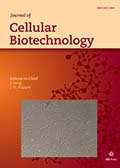Authors: Garus-oas, Carol Hermionee | Posten, Clemens
Article Type:
Research Article
Abstract:
BACKGROUND: Microalgae species for industrialization are largely selected because of their high lipid and biomass productivity. Both marine and freshwater species exhibit variations in biochemical compositions (i.e. lipid, carbohydrate and protein accumulation in biomass) when cultivated under varying environmental conditions. There is very little research available on the physiological responses of N. limnetica SAG 18.99 in terms of growth rates, biomass and lipid productivity when cultivated under variant nitrogen concentrations. OBJECTIVES: The objective of this research was to observe the physiological responses of Nannochloropsis limnetica (N. limnetica SAG 18.99) in terms of growth rates, biomass
…and neutral intracellular lipid when cultivated under variant nitrate concentrations. The null hypothesis was there is no significant difference in growth rate, biomass and neutral intracellular lipid productivity of N. limnetica SAG 18.99 cultivated under variant nitrate concentrations. METHODS: N. limnetica SAG 18.99 was cultivated under “normal nitrate” (3.53 M), “nitrate replete” (7.06 M), “moderate nitrate deplete” (1.765 M), and “high nitrate deplete” (0.8825 M) under the same conditions of light, pH, temperature and CO2 concentration over the duration of 14 days. The parameters measured during the cultivation were optical density to measure growth rates, flow-cytometry to measure cell concentrations/density, gravimetrical measurements for bio dry mass/biomass (BDM), ion chromatography measurements for ions/macronutrients, pH as well as sterility tests. All statistical analyses were performed using the SPSS software package (IBM statistics Version 23) and differences in data were considered significant at p < 0.05. RESULTS: Growth rates were statistically significant (p = 0.001). Therefore, the null hypothesis was rejected. Bio dry mass was not significant (p = 0.939). Therefore, the null hypothesis was accepted. Relative fluorescence data recorded for all of the four flasks was not significant (p = 0.112). Therefore, the null hypothesis was accepted. pH was not statistically significant (p > 0.05), which means it remained constant and, therefore, had no influence on the cultivation process. CONCLUSIONS: Biomass production exponentially increased in each of the four flasks throughout the cultivation. Relative fluorescence data recorded for all of the four flasks was the highest on the first couple of days during the lag phase and decelerated towards the end of the cultivation period. It was discovered that the success of the Nile red method in assessment of lipids is species dependent. Therefore, other gravimetric and chromatography methods (i.e. gas liquid chromatography, flow cytometry, low field nuclear magnetic resonance) must be employed together with or independent of it. Furthermore, the study recommends future researchers to look into the physiological responses of N. limnetica SAG 18.99 when cultivated under other macronutrient concentrations (i.e. phosphate) and variant environmental parameters (i.e. variations in light intensity, CO2 ).
Show more
Keywords: Microalgae, growth rate, biomass, neutral intracellular
lipid, Nannochloropsis limnetica (N. limnetica SAG 18.99)
DOI: 10.3233/JCB-209006
Citation: Journal of Cellular Biotechnology,
vol. 6, no. 1, pp. 1-11, 2020
Price: EUR 27.50





